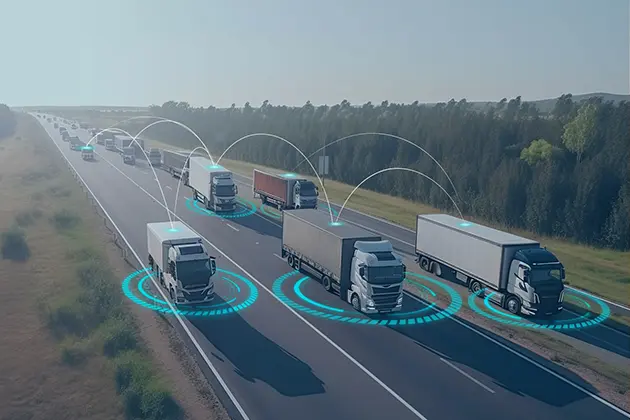In the modern business environment, staying compliant with industry regulations is no longer just about avoiding penalties; it has become a critical aspect of operational success. One tool that has been instrumental in helping U.S. businesses achieve this balance between compliance and profitability is telematics. With advancements in technology, telematics systems have evolved into more than just tracking tools. They now offer comprehensive solutions that enhance operational efficiency, reduce costs, and help businesses stay compliant with evolving regulations.
Telematics refers to the technology that integrates telecommunications with informatics, allowing the exchange of data between systems and devices. This technology typically involves the use of GPS, sensors, and onboard diagnostics systems to monitor and manage vehicle and asset operations. Telematics provides businesses with real-time insights into vehicle location, driving behavior, fuel usage, and maintenance needs. For industries reliant on fleets, such as logistics, construction, and delivery services, telematics has become an indispensable tool for optimizing performance while maintaining compliance with safety and environmental regulations.
Ensuring Compliance with Industry Regulations
One of the primary drivers behind the adoption of telematics by U.S. businesses is the need to comply with regulations. The Federal Motor Carrier Safety Administration (FMCSA), for example, mandates that commercial motor vehicles adhere to strict rules regarding hours of service (HOS), vehicle inspections, and driver behavior. Failure to comply with these regulations can result in hefty fines, legal issues, and reputational damage.
Telematics systems help businesses stay compliant by automatically tracking and recording key data points. For instance, telematics can monitor driver hours, ensuring that they do not exceed the federally mandated driving limits. It also helps fleet managers detect any potential safety violations, such as speeding or harsh braking, which could put both the driver and the company at risk. Additionally, telematics systems can automate the process of tracking and scheduling vehicle maintenance, ensuring that inspections are carried out on time, which is crucial for maintaining safety standards and preventing costly breakdowns.
Reducing Operating Costs
While compliance is a significant concern for businesses, telematics also offers a host of features that help reduce operating costs. Fuel costs are one of the largest expenses for companies with fleets. Telematics systems provide detailed reports on fuel usage and can identify inefficiencies such as excessive idling, unauthorized vehicle usage, and inefficient routing. By analyzing this data, fleet managers can make informed decisions to optimize routes, reduce idle times, and ensure that drivers are operating vehicles in the most fuel-efficient manner possible.
Another cost-saving benefit of telematics is improved vehicle maintenance. Predictive maintenance, powered by telematics, alerts fleet managers when a vehicle needs servicing based on real-time data. This approach helps businesses avoid the high costs associated with unexpected breakdowns and repairs. Moreover, it ensures that vehicles are running at peak performance, which extends their lifespan and reduces the total cost of ownership.
Additionally, telematics enables businesses to reduce insurance premiums. Insurance companies often offer discounts to companies that implement telematics systems because these systems provide valuable data on driver behavior, vehicle health, and safety compliance. By proving that a business is proactive in managing risk, companies can negotiate lower premiums and demonstrate that they are less likely to be involved in costly accidents or claims.
Enhancing Productivity and Efficiency
Beyond compliance and cost savings, telematics significantly improves overall productivity and operational efficiency. Real-time tracking allows businesses to monitor their assets and make adjustments on the fly. For example, if a delivery is running late due to traffic or an unexpected delay, fleet managers can reroute other vehicles or communicate with drivers to ensure the quickest possible delivery.
Telematics also fosters better communication between drivers and fleet managers. Instant communication via telematics systems allows managers to provide updated instructions, alert drivers to hazards, and resolve issues immediately. The system’s ability to track deliveries, service calls, or other business operations in real time enables managers to optimize workflows and ensure that resources are allocated efficiently.
For businesses with a mobile workforce, telematics can also serve as a tool for workforce management. By tracking the location of employees and assets, businesses can better manage their teams, allocate jobs more efficiently, and ensure that tasks are completed in a timely manner. This level of visibility and control helps companies reduce downtime and boost overall productivity.
Using Data for Strategic Decision-Making
One of the most valuable aspects of telematics is its ability to generate large amounts of actionable data. Over time, businesses can use this data to identify trends and make informed decisions about their operations. For example, if a company notices that a particular vehicle is frequently requiring repairs, it may be more cost-effective to replace the vehicle rather than continue with costly maintenance.
The data gathered from telematics can also help businesses evaluate driver performance. By monitoring metrics such as fuel efficiency, idle time, and speed, businesses can identify top-performing drivers and those who may need additional training or support. This data-driven approach allows businesses to make better decisions regarding hiring, training, and resource allocation.
In addition, telematics data can be used to improve customer service. By providing customers with real-time updates on the location of their deliveries or services, businesses can enhance customer satisfaction and build stronger relationships. This transparency also allows companies to manage customer expectations more effectively, which can lead to repeat business and referrals.
Telematics and Radius
For businesses seeking comprehensive telematics solutions, platforms like those provided by Radius Telematics (https://www.radius.com/en-us/) offer a wide range of services designed to optimize fleet management and ensure compliance with U.S. regulations. Radius Telematics provides real-time tracking, fuel monitoring, and compliance management tools that enable businesses to stay ahead of industry standards while improving operational efficiency. Their system offers an intuitive user interface, making it easy for businesses to access valuable data and manage their fleets effectively.
Radius Telematics also helps businesses maintain compliance with the latest regulatory requirements, including FMCSA guidelines, ensuring that fleet managers have the tools they need to keep their operations running smoothly and legally. By choosing a provider like Radius, companies can take advantage of the latest technology in telematics while focusing on growing their business and improving profitability.
Conclusion
Telematics has become a game-changer for U.S. businesses, offering a powerful combination of compliance management, cost reduction, and enhanced operational efficiency. By adopting telematics systems, businesses can not only ensure that they meet stringent regulatory standards but also unlock new opportunities for profitability. From reducing fuel costs to enhancing customer service, telematics provides valuable insights that enable businesses to make data-driven decisions and streamline their operations.
In a competitive marketplace where every advantage counts, leveraging telematics is a strategic move that not only safeguards a company’s compliance but also drives its profitability forward. As more businesses recognize the benefits of this technology, it is clear that telematics will continue to play a crucial role in shaping the future of business operations across a wide range of industries in the U.S.










